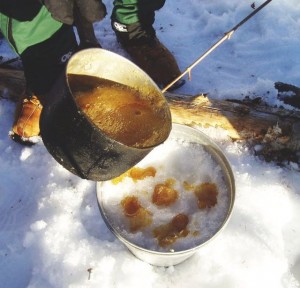From Sap to Syrup
Last week I gave you some background in tapping your own maple trees to get sap. That sap can be turned into syrup – that delicious treat we like to put onto our pancakes and waffles. It takes a bit of work to get it there, though. If you’re looking to make your own, this might be a good starting point but you’ll need to do a little more research beyond this blog. If you’re just curious, this is the place to be.
Sap
Sap is essentially a tree’s life force. It is the sugars, minerals, and nutrients that the tree transports through its xylem. It is a combination of elements picked up by the roots and the sugars created through photosynthesis.
The sap that comes from the maple tree can be stored below 3°C for up to 7 days. Beyond that and it starts to spoil.
Making Syrup
The sugary liquid that comes from a tree is not syrup, but sap. Syrup is the concentrated form of sap. There is a great deal of boiling that needs to happen before sap can become concentrated enough to be called syrup. To give you an idea, if you wanted to make 1 L of syrup, you would need 40 L of sap. No that’s not a typo, it’s a 40:1 ratio of sap to syrup.
The actual boiling process is quite involved which is why I’m going to direct you to Tap My Trees, a wealth of information where syrup making is concerned.
If you’re serious about this venture, be sure to read the fine details. As a friend has told me, an extra minute of boiling can make or break your batch. Perhaps it’s best to start in small batches so all of the sap is not wasted.
Maple Treats
If you visit Québec or Northern Ontario in the winter, you are sure to come across a festival or museum giving you the opportunity to enjoy frozen maple treats made by pouring hot syrup onto a ball of snow. The snow cools down the syrup, freezing it so it can be picked up on a stick and eaten on the spot. In Québec they call it “tire sur la neige”, which literally translates to “taffy on the snow”.

This novelty treat isn’t the only way to enjoy the sweetness. Maple Syrup World, just one of hundreds of websites dedicated to providing you with uses for maple syrup, lists recipes for everything from dessert to the main course and everything in between.
Maple syrup is truly a defining characteristic of this great country. I’m proud to think that visitors from other countries ask about the syrup and are inclined to give it a try (and likely take some home!). It tells me not that we are suckers for something sweet but that we have vast forests filled with maple trees capable of providing us with more than paper and wood products.
Enjoy your fresh maple syrup this season and remember that 40 to 1 ratio…a lot of sap from a lot of trees goes into making that syrup for you (if you’re using the real stuff, but that’s a story for a different blogger).



